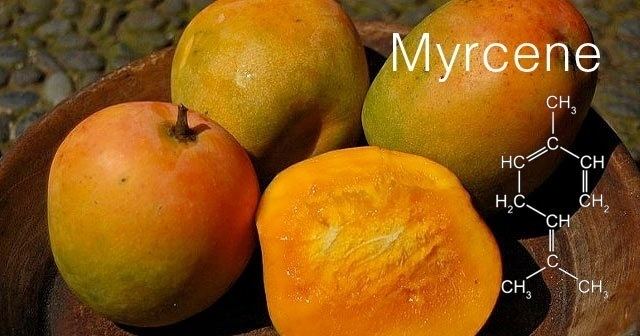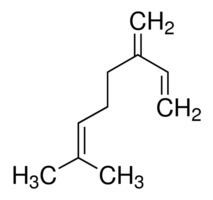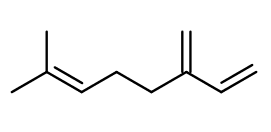Formula C10H16 | Density 794 kg/m³ | |
 | ||
Myrcene, or β-myrcene, is an olefinic natural organic hydrocarbon. It is more precisely classified as a monoterpene. Monoterpenes are dimers of isoprenoid precursors, and myrcene is one of the most important. It is a component of the essential oil of several plants including bay, cannabis, ylang-ylang, wild thyme, parsley, and hops. It is produced mainly semi-synthetically from myrcia, from which it gets its name. It is a key intermediate in the production of several fragrances. α-Myrcene is the name for the structural isomer 2-methyl-6-methylene-1,7-octadiene, which is not found in nature and is little used.
Contents
- Biosynthesis and production
- Use in fragrance industry
- Partial list of the plants that contain myrcene
- References

Biosynthesis and production

Terpenes arise naturally from dehydration of terpenol geraniol. It could in principle be extracted from any number of plants, for example wild thyme, the leaves of which contain up to 40% by weight of myrcene. The current route to commercial samples is by the pyrolysis (400 °C) of β-pinene, which is obtained from turpentine.
Use in fragrance industry

Myrcene is an important intermediate used in the perfumery industry. It has a pleasant odor, but is rarely used directly. It is also unstable in air, tending to polymerize. Samples are stabilized by the addition of alkylphenols or tocopherol. It is thus more highly valued as an intermediate for the preparation of flavor and fragrance chemicals such as menthol, citral, citronellol, citronellal, geraniol, nerol, and linalool. Treatment of myrcene with hydrogen chloride gives geranyl chloride, neryl chloride, and linalyl chloride. Treatment of these compounds with acetic acid gives geranyl acetate, neryl acetate, and linalyl acetate, respectively. These esters are then hydrolyzed to the corresponding alcohols. Myrcene is also converted to myrcenol, another fragrance found in lavender, via uncatalyzed hydroamination of the 1,3-diene followed by hydrolysis and Pd-catalyzed removal of the amine.

As 1,3-dienes, both myrcene and mycenol undergo Diels-Alder reactions with several dienophiles such as acrolein to give cyclohexene derivatives that are also useful fragrances.
Partial list of the plants that contain myrcene
As mentioned above, many plants contain myrcene, sometimes in very large amounts.
